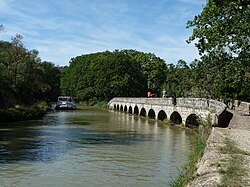
The Canal du Midi is a 240 km (150 mi) long canal in Southern France. Originally named the Canal Royal en Languedoc and renamed by French revolutionaries to Canal du Midi in 1789, the canal is considered one of the greatest construction works of the 17th century.

The Briare Canal is one of the oldest canals in France. Its construction started in 1604. It was the first summit level canal in Europe that was built using pound locks, connecting the Rhone-Saône and Seine valleys. It is 57 kilometres long and is part of the Bourbonnais route from Saint-Mammès on the Seine to Chalon-sur-Saône on the Saône.

Navigable aqueducts are bridge structures that carry navigable waterway canals over other rivers, valleys, railways or roads. They are primarily distinguished by their size, carrying a larger cross-section of water than most water-supply aqueducts. Roman aqueducts were used to transport water and were created in Ancient Rome. The 662-metre (2,172 ft) long steel Briare aqueduct carrying the Canal latéral à la Loire over the River Loire was built in 1896. It was ranked as the longest navigable aqueduct in the world for more than a century, until the Magdeburg Water Bridge in Germany took the title in the early 21st century.

Azille is a commune in the Aude department in the Occitanie region of southern France.

The Canal de Garonne, formerly known as Canal latéral à la Garonne, is a French canal dating from the mid-19th century that connects Toulouse to Castets-en-Dorthe. The remainder of the route to Bordeaux uses the river Garonne. It is the continuation of the Canal du Midi which connects the Mediterranean with Toulouse.

There are 91 working locks on the Canal du Midi along its 240-kilometre (150 mi) course from the Bassin du Thau on the Mediterranean coast to the junction with the Canal lateral a la Garonne in Toulouse. There are a further 13 locks on the 37-kilometre (23 mi) La Nouvelle branch which runs through Narbonne to the Mediterranean at Port-la-Nouvelle. The locks are all under the management of the French navigation authority, Voies navigables de France.
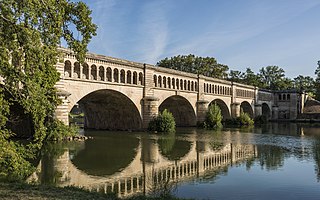
The Orb Aqueduct is a bridge which carries the Canal du Midi over the Orb in the city of Béziers in Languedoc, France. The aqueduct is 28 metres (92 ft) wide, 12 metres (39 ft) tall and at 240 metres (790 ft) is the longest on the Canal du Midi.
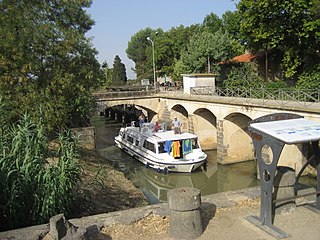
Ouvrages du Libron is a structure like no other on the Canal du Midi. It allows the Libron River, near Agde in south-west France, to traverse the Canal du Midi. At the point of intersection, the Libron is more or less at the same level as the Canal du Midi so a traditional aqueduct was not an option. The problem was further exacerbated by the Libron's propensity to flash flood up to twenty times a year. The problem was originally solved by the building of a pontoon aqueduct known as the Libron Raft which utilised a flush-decked barge to protect the canal channel in times of flooding. However, this was replaced by the present structure in 1855.

The Bassin de Saint-Ferréol was created as the result of a large earth dam across the mouth of the valley of Laudot stream at St. Ferréol in the Montagne Noire. It was originally proposed by Chevalier de Clerville and accepted by Pierre Paul Riquet as an integral part of the Canal du Midi. Riquet needed to provide a sufficient water reservoir to allow the locks to function year round, even in the dry summer season. The dam was begun on 15 April 1667 and was completed in four years. It was the first dam built specifically to supply water to a navigable canal and was by far the greatest single work of civil engineering undertaken during the building of the Canal du Midi.

Cesse Aqueduct is one of several aqueducts, or water bridge, created for the Canal du Midi. Originally, the canal crossed the Cesse on the level. Pierre-Paul Riquet, the original architect of the canal, had placed a curved dam 205 metres (673 ft) long and 9.10 metres (29.9 ft) high across the Cesse in order to collect water to make the crossing possible; the aqueduct replaced this dam.
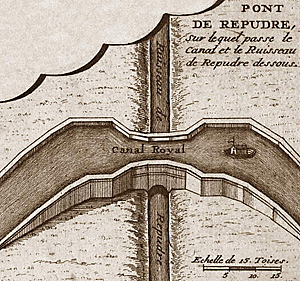
The Répudre Aqueduct is the first aqueduct built on the Canal du Midi. Pierre-Paul Riquet designed it to cross the Répudre River. It was built by Emmanuel d'Estan. It was designed in 1675 and completed in 1676, but was severely damaged that winter and had to be rebuilt. It is one of three original aqueducts created by Pierre-Paul Riquet during the building of the canal from 1667 to 1681.
The Hers Aqueduct is one of several aqueducts, or water bridges, created for the Canal du Midi. It crosses the river Hers-Mort near the village of Renneville, south of Villefranche-de-Lauragais. The structure was first built in 1688–1690, but the present structure is the result of modifications by Jean-Polycarpe Maguès in 1806, chief engineer on the Canal du Midi. It has been listed since 1998 as a monument historique by the French Ministry of Culture.
The Orbiel Aqueduct is one of several aqueducts on the Canal du Midi. Until its building, the canal crossed the River Orbiel on the level. A dam on the Orbiel was demolished and replaced with the Aqueduct. It was built in 1686-87 by Antoine Niquet and designed by Marshal Sebastien Vauban, It is found in the city of Trèbes.
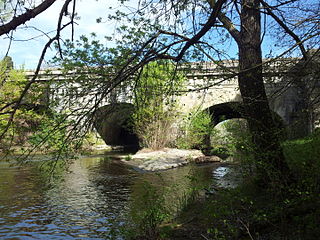
The Fresquel Aqueduct is one of several aqueducts on the Canal du Midi. Until its building, the canal crossed the River Fresquel on the level. Built in 1802–1810, the structure is near Carcassonne. It was built when the canal was rerouted to pass through Carcassonne.
The Ognon Aqueduct is one of several aqueducts on the Canal du Midi. It was built in 1826-27 to replace the troublesome level crossing of the Ognon River.
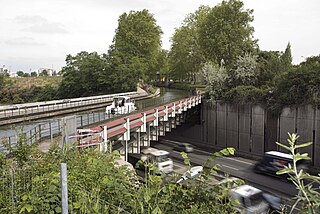
The Herbettes Aqueduct is one of several aqueducts on the Canal du Midi. In Toulouse France, it carries the canal over a four-lane highway in a metal trough. The trough has been colorfully painted underneath. The aqueduct is about 2 km (1.2 mi) from the Port Saint-Sauveur.
The Aiguille Aqueduct is one of several aqueducts on the Canal du Midi. In Puichéric France, it carries the canal over a small stream, the Rigole de l'Etang. It is one of three original aqueducts created by Pierre-Paul Riquet during the building of the canal from 1667 to 1681.
The Jouarres Aqueduct is one of several aqueducts on the Canal du Midi. In Jouarres le Vieux France, it carries the canal over a small stream. It is one of three original aqueducts created by Pierre-Paul Riquet during the building of the canal from 1667 to 1681.

Aqueducts on the Canal du Midi allow the canal to intersect and cross over natural streams. There are two exceptions, the first is the Herbettes Aqueduct where it crosses a four-lane highway in Toulouse. Another exception is where it intersections with the Libron river and the crossing is accomplished via the Ouvrages du Libron.
The balancing of incoming and outgoing water allows the Canal du Midi to operate as it does. Each time a lock operates, large quantities of water are either required to fill it or dump from it into the lower level pound. There must be a constant source of water in order to fill and the excess water dumped must have a place to exit the canal without it overflowing. Being able to provide this water source was one of the most important problems to be solved by Pierre Paul Riquet, its creator.
